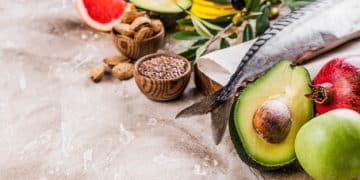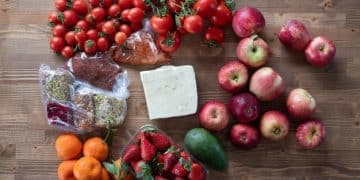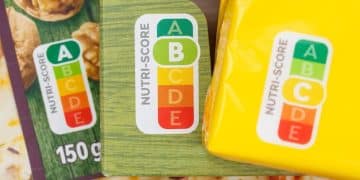Sugar Shock: Cut 25% Added Sugar in 30 Days
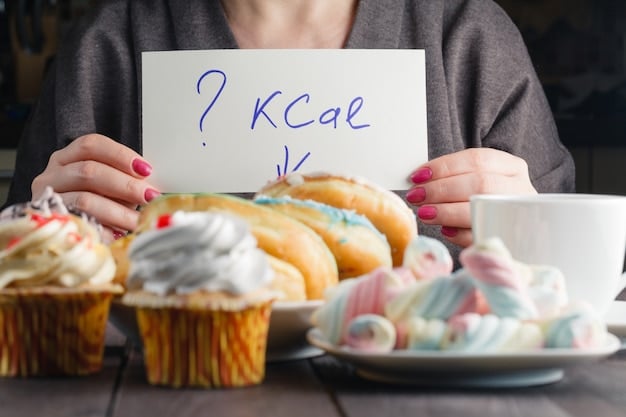
Achieving “sugar shock” by cutting 25% of added sugar in 30 days involves strategic dietary changes, focusing on whole foods, reducing processed items, and mindful consumption habits to significantly improve health outcomes.
Embarking on a journey to reduce sugar intake can feel daunting, yet the benefits are undeniable. This guide will walk you through how to navigate the “Sugar Shock: How to Cut 25% of Added Sugar From Your Diet in 30 Days,” providing actionable strategies to significantly reduce your consumption of added sugars within a single month. Understanding where hidden sugars lie and making informed choices are crucial steps toward a healthier lifestyle, potentially transforming your relationship with food.
Understanding the Impact of Added Sugar on Your Health
Added sugars are ubiquitous in the modern diet, often lurking in unexpected places from breakfast cereals to savory sauces. Their pervasive presence contributes to a myriad of health issues, extending beyond basic weight gain. These sugars not only add unnecessary calories but also lack essential nutrients, making them “empty” calories.
The human body processes added sugars differently than natural sugars found in fruits and whole foods. When consumed in excess, added sugars can overwhelm the liver, which converts them into fat, contributing to non-alcoholic fatty liver disease. This metabolic burden can cascade into more systemic problems.
The Silent Health Saboteur: Chronic Disease Risk
Excessive intake of added sugars is a significant driver of chronic inflammation, a foundational element in many modern diseases. This inflammation isn’t just about joint pain; it operates at a cellular level, impairing bodily functions and increasing vulnerability.
- Increased Risk of Type 2 Diabetes: Consistent high sugar intake leads to insulin resistance, making it harder for cells to absorb blood sugar, ultimately leading to elevated blood glucose levels.
- Heart Disease: Sugary diets are linked to higher blood pressure, increased harmful LDL cholesterol, and elevated triglycerides, all risk factors for cardiovascular disease.
- Obesity and Weight Gain: Sugars contribute to calorie surplus without providing satiety, leading to overconsumption and fat accumulation, particularly visceral fat around organs.
- Non-Alcoholic Fatty Liver Disease (NAFLD): As the liver processes fructose, large amounts can be turned directly into fat, accumulating in the liver.
Beyond these primary concerns, a diet high in added sugars can also negatively impact cognitive function, contributing to a higher risk of dementia and memory problems. It can also disrupt the gut microbiome, leading to digestive issues and potentially affecting mood and immunity. Understanding these profound impacts is the first motivational step toward reducing consumption, as it highlights the tangible benefits that can be reaped.
The scientific consensus continues to reinforce the detrimental effects of excessive sugar. Studies consistently show a correlation between high sugar consumption and adverse health outcomes across various populations and demographics. This evidence underscores the urgency and importance of addressing this dietary challenge.
Identifying Hidden Sugars in Your Everyday Diet
One of the biggest hurdles in cutting down on added sugars is their stealthy presence in countless food products. Many consumers are unaware of just how much sugar they’re consuming, often because it’s disguised under myriad names and incorporated into items not typically associated with sweetness.
Reading food labels becomes an investigative task. Manufacturers often use terms that sound healthier or less like sugar, making it challenging for the average shopper to decipher. Beyond the obvious “sugar,” you might encounter sweeteners derived from corn, fruit, or even seemingly natural sources.
Decoding Food Labels: The Sugar Dictionary
To effectively identify hidden sugars, it’s essential to familiarize yourself with their aliases. This knowledge empowers you to make more informed choices at the grocery store.
- Syrups: High-fructose corn syrup, corn syrup, rice syrup, malt syrup, glucose syrup.
- Sugars: Dextrose, fructose, glucose, lactose, maltose, sucrose. Also look out for brown sugar, cane sugar, raw sugar, invert sugar, evaporated cane juice.
- Nectars & Concentrates: Fruit juice concentrate, agave nectar, maple syrup, honey. While some of these might have natural origins, they are still concentrated forms of sugar when added to processed foods.
These ingredients are frequently found in products like salad dressings, condiments (ketchup, BBQ sauce), bread, yogurt, granola bars, and even seemingly savory items like pasta sauces and canned soups. The sheer volume and variety can be overwhelming, but becoming a label detective is a crucial habit to cultivate.
Consider a simple example: a typical loaf of whole wheat bread might contain added sugar to enhance flavor and texture. A serving of yogurt marketed as “healthy” could have more added sugar than a candy bar. These examples illustrate the importance of scrutinizing ingredient lists rather than relying solely on front-of-package claims or assumed healthfulness. The location of sugar on an ingredient list also provides a clue: if it’s among the first few ingredients, it means a significant amount is present.
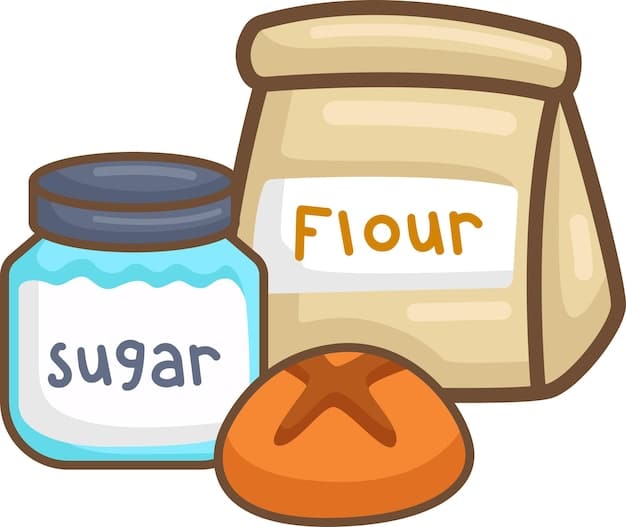
Phased Approach: Weeks 1 & 2 Strategies for Sugar Reduction
Successfully cutting 25% of added sugar in 30 days requires a methodical, phased approach rather than an abrupt overhaul. The first two weeks should focus on gradual changes, building awareness, and developing sustainable habits. This reduces the shock to your system and minimizes withdrawal symptoms, making the transition smoother and more likely to stick.
The initial phase involves observing current consumption patterns and identifying the easiest targets for reduction. This might mean swapping out one sugary drink a day for water, or choosing a plain yogurt instead of a fruit-flavored one. Small, consistent steps accumulate into significant progress.
Week 1: Awareness and Initial Swaps
The goal for the first week is to become acutely aware of your sugar intake without necessarily eliminating everything. This observational phase is critical for building a foundation of understanding your personal “sugar landscape.”
- Track Your Intake: For a few days, simply log every food and drink you consume, noting any added sugars listed on labels. This will reveal your biggest sugar sources.
- Eliminate Sugary Drinks: This is often the easiest and most impactful first step. Replace soda, sweetened teas, and fruit juices with water, unsweetened sparkling water, or unsweetened herbal tea.
- Scrutinize Breakfast Foods: Many breakfast cereals, pastries, and instant oatmeal packets are loaded with sugar. Opt for plain oatmeal with fruit, eggs, or whole-grain toast.
Focus on one or two key areas to tackle first. For instance, if sugary beverages are a major part of your diet, prioritize their elimination. If your breakfast choices are sugar-laden, making changes there can yield immediate results. Don’t try to change everything at once; sustained effort in a few areas is more effective than an unsustainable attempt at total overhaul.
Week 2: Deeper Dives and Strategic Substitutions
Building on the foundation of Week 1, the second week aims for deeper cuts, targeting less obvious sources of added sugar and introducing healthier alternatives. This phase requires more active substitution.
- Rethink Condiments and Sauces: Swap out sugary ketchups, BBQ sauces, and salad dressings for homemade versions or brands with no added sugar. Vinegars, olive oil, herbs, and spices are excellent flavor enhancers.
- Address Dairy and Snacks: Switch from sweetened yogurts to plain varieties, adding fresh fruit or a sprinkle of cinnamon for flavor. Choose nuts, seeds, or fresh vegetables as snacks instead of processed bars or pastries.
- Control Dessert Intake: Instead of daily desserts, institute a rule like “dessert twice a week” or switch to fresh fruit as your primary sweet treat post-meals.
By the end of Week 2, you should feel a tangible shift in your palate, with fewer cravings for intensely sweet items. Your body begins to adjust, and you’ll likely notice improved energy levels and potentially better sleep. This phased approach allows your taste buds to adapt, making the journey less of a struggle and more of a discovery.
Advanced Strategies: Weeks 3 & 4 for Sustained Reduction
Having navigated the initial challenges, Weeks 3 and 4 are about refining your approach, incorporating advanced strategies, and solidifying long-term habits. This period focuses on meal preparation, mindful eating, and understanding the role of your overall diet in managing sugar intake. The aim is to make sugar reduction feel less like a temporary diet and more like an integrated part of your lifestyle.
At this stage, you’re likely more attuned to your body’s signals and the subtleties of natural sweetness. This heightened awareness allows for more sophisticated modifications to your eating patterns and food choices. The focus shifts from elimination to intelligent substitution and prevention.
Week 3: Cooking at Home and Mindful Eating
Taking control of your kitchen is one of the most powerful steps in reducing added sugar. When you cook at home, you have complete oversight of ingredients, ensuring no hidden sugars sneak into your meals. Mindful eating complements this by enhancing your connection with food.
- Prioritize Home-Cooked Meals: Aim to cook at least 80% of your meals at home. This allows you to choose fresh ingredients and avoid the processed additives common in restaurant and convenience foods.
- Experiment with Natural Sweeteners (in moderation): If you need a touch of sweetness, consider small amounts of pure maple syrup, raw honey, or dates in recipes, but use them sparingly. The goal is to retrain your palate to appreciate less sweetness.
- Practice Mindful Eating: Pay attention to your hunger and fullness cues. Eat slowly, savoring each bite. This can help reduce emotional eating and unconscious snacking on sugary items.
Meal prepping on weekends can make weekday home cooking much easier. Preparing large batches of grains, roasted vegetables, and lean proteins can provide a foundation for quick and healthy meals throughout the week, reducing the temptation to rely on convenience foods. Learning to season your food with herbs and spices rather than relying on sugary sauces also expands your culinary repertoire.
Week 4: Reading Between the Lines and Long-Term Planning
The final week is about consolidating your gains and planning for sustainable, long-term sugar management. This involves becoming an expert label reader and developing strategies for social situations and cravings.
- Become a Label Expert: Beyond identifying sugar aliases, compare nutrition labels between similar products. Choose the item with the lowest “added sugars” content, noting the grams per serving.
- Address Emotional Eating: Identify triggers for emotional or stress-induced sugar cravings. Develop alternative coping mechanisms such as exercise, meditation, or social connection.
- Strategize for Social Events: Plan ahead when attending parties or dining out. Offer to bring a sugar-free dish, choose water over sugary drinks, and be assertive about your dietary choices.
By the end of 30 days, you should have not only cut 25% of added sugar but also gained invaluable knowledge and habits that support a healthier lifestyle. The “sugar shock” will have passed, replaced by a more balanced and energetic you. Remember, this is a journey, and occasional indulgences happen; the key is consistency and returning to your healthy habits.
Navigating Cravings and Setbacks on Your Journey
Reducing sugar intake can often lead to withdrawal symptoms, including intense cravings. These cravings are a natural part of the body’s adjustment process as it weans itself off a substance it has become dependent on. Understanding that these feelings are temporary and manageable is key to pushing through them. Setbacks are also an inevitable part of any significant dietary change; how you respond to them defines your success.
When a craving strikes, it’s helpful to pause and identify its true source. Is it physical hunger, emotional need, or simply a habit? Distinguishing between these can guide your response and prevent unnecessary sugar consumption.
Effective Strategies to Combat Cravings
Successfully overcoming cravings requires a toolkit of diversions and healthy alternatives. Being prepared for these moments can significantly increase your chances of staying on track.
- Hydrate Immediately: Often, what feels like a craving for sugar is actually a sign of dehydration. Drink a large glass of water and wait 10-15 minutes.
- Opt for Whole Fruits: If you need something sweet, reach for a piece of fruit. The fiber in whole fruits helps slow down sugar absorption, providing natural sweetness without the rapid blood sugar spike.
- Engage in a Distraction: Cravings typically last only 15-20 minutes. Engage in an activity that fully occupies your mind and body, such as going for a walk, calling a friend, or reading a book.
- Increase Protein & Fiber Intake: Meals rich in protein and fiber promote satiety, stabilizing blood sugar and reducing the likelihood of intense cravings later on.
Keeping healthy snacks readily available is also a proactive strategy. Having unsalted nuts, seeds, vegetable sticks with hummus, or small portions of plain yogurt on hand can deter you from reaching for easily accessible sugary treats. The absence of tempting items in your environment makes resisting cravings much easier.
Bouncing Back from Setbacks
A setback is a temporary deviation, not a permanent failure. It’s crucial to view them as learning opportunities rather than reasons to abandon your goals entirely.
- Acknowledge Without Guilt: If you overindulge, acknowledge it without dwelling on guilt or self-blame. Recognize that it happened, and move on.
- Identify the Trigger: Reflect on what led to the setback. Was it stress, a social event, or lack of preparation? Understanding the trigger helps prevent similar situations in the future.
- Recommit & Restart: Don’t let one misstep derail your entire progress. Immediately recommit to your plan and restart your healthy habits with your very next meal or snack.
Building resilience to setbacks is a critical skill for any health journey. Every successful individual encounters obstacles; their success stems from their ability to learn and adapt. Remember your “why” – the health benefits and improved well-being – to reinforce your motivation and guide you back on track.
Beyond the 30 Days: Maintaining a Low-Sugar Lifestyle
Completing the 30-day “Sugar Shock” challenge is a significant accomplishment, but the journey towards a low-sugar lifestyle doesn’t end there. The true success lies in sustaining these healthy habits long-term. This transition requires continued mindfulness, adaptability, and a proactive approach to your dietary choices, ensuring that sugar remains a controlled element rather than a dominant one in your life.
The goal isn’t necessarily to eliminate all added sugar forever, which can be unrealistic and lead to feelings of deprivation. Instead, it’s about developing a balanced relationship with food where sugar is an occasional indulgence rather than a staple ingredient. This balance allows for flexibility without compromising overall health goals.
Building Sustainable Habits for Long-Term Success
Maintaining a low-sugar lifestyle involves integrating the lessons learned during the 30-day challenge into daily routines. This means making healthier defaults the norm and strategically planning for potential pitfalls.
- Continue Label Reading: Make label scrutiny a permanent habit. Even products you regularly buy can change formulations, potentially adding more sugar.
- Prioritize Whole Foods: Base your diet around whole, unprocessed foods like vegetables, fruits, lean proteins, and whole grains. These naturally low-sugar options form the backbone of a healthy diet.
- Master Meal Prep: Continue or begin regular meal planning and preparation to ensure you always have healthy, low-sugar options available, reducing reliance on convenience foods.
- Listen to Your Body: Pay attention to how different foods affect your energy levels, mood, and overall well-being. This personal feedback can guide your choices.
Developing a diverse palate that appreciates savory, bitter, and naturally sweet flavors is also crucial. As your taste buds reset, you’ll find that foods once considered bland become flavorful, and overly sweet items become unpleasantly cloying. This natural re-calibration is one of the most rewarding aspects of reducing sugar.
Adapting to Social Situations and Special Occasions
Life is full of celebrations and social gatherings where sugary foods are often present. Instead of feeling restricted, develop strategies to navigate these situations gracefully and without derailing your progress.
- Strategic Indulgence: Allow for occasional, planned treats. This might mean having a small slice of cake at a birthday party or a single scoop of ice cream. The key is moderation and conscious choice.
- Bring Healthy Options: When attending potlucks or gatherings, offer to bring a delicious, low-sugar dish that you know you can enjoy.
- Focus on Non-Food Aspects: Shift your focus from the food to the company, conversation, and experience of the event.
Your journey beyond the 30 days is about empowerment and freedom, not deprivation. It’s the freedom from sugar cravings, the increased energy, and the peace of mind that comes from knowing you are nurturing your body. Embrace this ongoing process with kindness and consistency.

Common Pitfalls and How to Avoid Them
Embarking on a sugar reduction journey, while immensely beneficial, is not without its challenges. Understanding the common pitfalls can help you preempt them, making your path smoother and more successful. Many individuals encounter similar obstacles, ranging from intense cravings to the deceptive marketing of “healthy” products. Preparedness is your best defense against these potential derailments.
One of the most frequent traps is underestimating the psychological component of sugar addiction. It’s not just a physical craving; it’s often linked to habit, comfort, and emotional associations. Addressing these deeper connections is crucial for long-term success.
Missteps to Watch Out For
Recognizing these common pitfalls allows you to develop strategies to avoid them proactively, safeguarding your progress and motivation.
- “Zero Sugar” Doesn’t Mean Healthy: Many products marketed as “sugar-free” or “diet” contain artificial sweeteners. While they may reduce calories from sugar, some studies suggest these can still impact gut health, perpetuate sweet cravings, and potentially have other adverse effects. Prioritize whole foods over artificially sweetened ones.
- Overreliance on Fruit & Natural Sweeteners: While better than refined sugar, even natural sugars in large quantities can spike blood sugar and contribute to caloric excess. Fruits should be consumed in moderation, and natural sweeteners like honey or maple syrup should be used sparingly.
- Ignoring Hidden Sugars in Savory Foods: As discussed, sugars are in sauces, bread, and condiments. Assuming a food is sugar-free because it isn’t traditionally sweet is a common oversight.
- Social Pressure and Lack of Preparation: Eating out, social gatherings, and peer pressure can easily lead to deviations. Without a plan (e.g., eating before, researching menus, choosing wisely), it’s easy to succumb.
Another subtle pitfall is the deprivation mindset. Focusing on what you “can’t have” can lead to resentment and eventual binges. Instead, shift your perspective to what you “can have” – a vast array of delicious, nutrient-dense foods that will leave you feeling energized and healthy. This positive framing reinforces your commitment.
Building a Resilient Approach
Avoiding pitfalls is about building resilience and having contingency plans. It’s about being smart about your choices and understanding the subtle ways sugar can re-enter your diet.
- Pre-Planning for Trigger Situations: If stress or specific events trigger cravings, have a non-food coping mechanism ready. This could be a healthy habit like exercise, meditation, or even a creative outlet.
- Educate Yourself Continuously: Stay informed about nutrition. The more you understand about how foods affect your body, the more empowered you become to make informed decisions.
- Communicate Your Goals: Share your sugar reduction goals with friends and family. Their understanding and support can be invaluable, and they might even join you.
Ultimately, a successful sugar reduction journey is about developing a sustainable relationship with food, one that prioritizes health and well-being over fleeting sugary pleasures. By being aware of these common pitfalls and proactively addressing them, you significantly increase your chances of not only reaching your 30-day goal but also maintaining a healthier, low-sugar lifestyle for years to come.
The Benefits Beyond Weight Loss: What You Can Expect
While weight loss is a common motivation for reducing sugar intake, the benefits extend far beyond the number on the scale. Cutting 25% of added sugar in 30 days can initiate a cascade of positive physiological and psychological changes, enhancing overall well-being. These broader improvements often become the most compelling reasons for individuals to maintain a low-sugar lifestyle long after the initial challenge is over.
The human body is remarkably resilient, and even moderate changes in diet can lead to significant improvements in various bodily systems. Understanding these multifaceted benefits can serve as powerful motivation and a testament to the profound impact of dietary choices.
Transformative Health Improvements
Many individuals report a surprising array of positive changes once they reduce their sugar intake, demonstrating the systemic effects of sugar on the body.
- Increased Energy Levels & Reduced Fatigue: Stabilizing blood sugar levels eliminates the dramatic peaks and crashes often associated with high sugar intake, leading to more consistent energy throughout the day and combating the afternoon slump.
- Improved Mood & Mental Clarity: Sugar has been linked to mood swings and even symptoms of anxiety and depression. Reducing it can lead to greater emotional stability, improved focus, and a clearer mind. The “brain fog” often associated with sugar consumption tends to lift.
- Better Sleep Quality: Sugary foods, especially close to bedtime, can disrupt sleep patterns. A lower-sugar diet often leads to more restorative and uninterrupted sleep.
- Enhanced Skin Health: High sugar intake can contribute to inflammation, which can manifest as acne and premature aging of the skin. Many people notice a clearer complexion and a more youthful glow after reducing sugar.
- Improved Digestion: A diet low in added sugars and high in fiber (from whole foods) supports a healthier gut microbiome, leading to better digestion and reduced bloating.
Beyond these immediate and noticeable changes, long-term sugar reduction can also lead to more robust bone health, a healthier immune system, and a reduced risk of certain cancers, though these benefits accrue over a more extended period. The body’s systems operate more efficiently when not burdened by excessive glucose and fructose.
A Shift in Palate and Relationship with Food
Perhaps one of the most profound benefits is the re-education of your taste buds. After 30 days of reduced sugar, your palate becomes more sensitive to natural sweetness, and foods once deemed bland become flavorful.
- Re-Sensitized Taste Buds: You’ll begin to appreciate the subtle sweetness in vegetables like carrots and bell peppers, and fruits will taste incredibly sweet.
- Reduced Cravings: As your body adapts, the intense cravings for sugary foods will diminish, making it easier to maintain your new habits.
- Empowered Food Choices: No longer driven by sugar addiction, you’ll feel more in control of your food choices, choosing nutrient-dense options because they make you feel good, not because you’re forcing yourself.
This shift represents a fundamental change in your relationship with food, moving from one of potential dependence to one of mindful nourishment. The benefits are not just about what you remove from your diet, but what you gain: vitality, clarity, and sustainable health.
| Key Point | Brief Description |
|---|---|
| 📊 Track & Identify | Monitor current sugar intake to find primary sources and hidden sugars in processed foods. |
| 🔄 Phased Swaps | Gradually replace sugary drinks and processed foods with whole, unsweetened alternatives over two weeks. |
| 🏠 Home Cooking & Mindful Eating | Prioritize cooking at home and practice mindful eating to control ingredients and appreciate natural flavors. |
| 🧘♂️ Manage Cravings | Stay hydrated, choose whole fruits, and use distraction techniques to manage sugar cravings effectively. |
Frequently Asked Questions About Sugar Reduction
▼
Added sugars are sweeteners and syrups put into foods during processing or preparation, like corn syrup or cane sugar. Natural sugars are intrinsically part of whole, unprocessed foods like fruits (fructose) and milk (lactose), often accompanied by fiber and nutrients. The concern lies with added sugars due to their high concentration and lack of nutritional value.
▼
Yes, it’s common to experience withdrawal symptoms such as cravings, headaches, fatigue, and irritability, particularly during the first few days of reducing sugar. These symptoms are usually temporary and subside as your body adjusts. Staying hydrated, eating balanced meals, and gentle exercise can help alleviate discomfort.
▼
Absolutely! Whole fruits are encouraged as they contain natural sugars along with essential fiber, vitamins, and minerals. The fiber helps slow sugar absorption, preventing rapid blood sugar spikes. However, fruit juices should be consumed mindfully, as they remove much of the fiber and concentrate the sugar.
▼
Look for ingredients ending in “-ose” (dextrose, fructose, glucose, maltose, sucrose), syrups (corn syrup, rice syrup), and other names like cane sugar, evaporated cane juice, honey, and agave nectar. Sugar aliases often appear multiple times on the ingredient list. The closer to the top an ingredient is, the more of it the product contains.
▼
Don’t be discouraged! Setbacks are a normal part of any significant dietary change. Acknowledge what happened without guilt, learn from the experience (e.g., what triggered it?), and simply recommit to your plan immediately. Progress isn’t linear; consistency over perfection is the key to long-term success.
Conclusion
Embarking on the “Sugar Shock” journey to cut 25% of added sugar in just 30 days is a transformational step towards enhanced health and well-being. By understanding the pervasive nature of hidden sugars, adopting a phased approach to reduction, and building resilient habits, you can successfully recalibrate your palate and mitigate the numerous adverse effects of excessive sugar consumption. The benefits extend far beyond weight management, encompassing improved energy, mood stability, better sleep, and a deeper appreciation for the natural flavors of whole foods. This challenge is more than just a diet; it’s an opportunity to gain control over your dietary choices and foster a healthier, more vibrant lifestyle that will serve you well for years to come.

